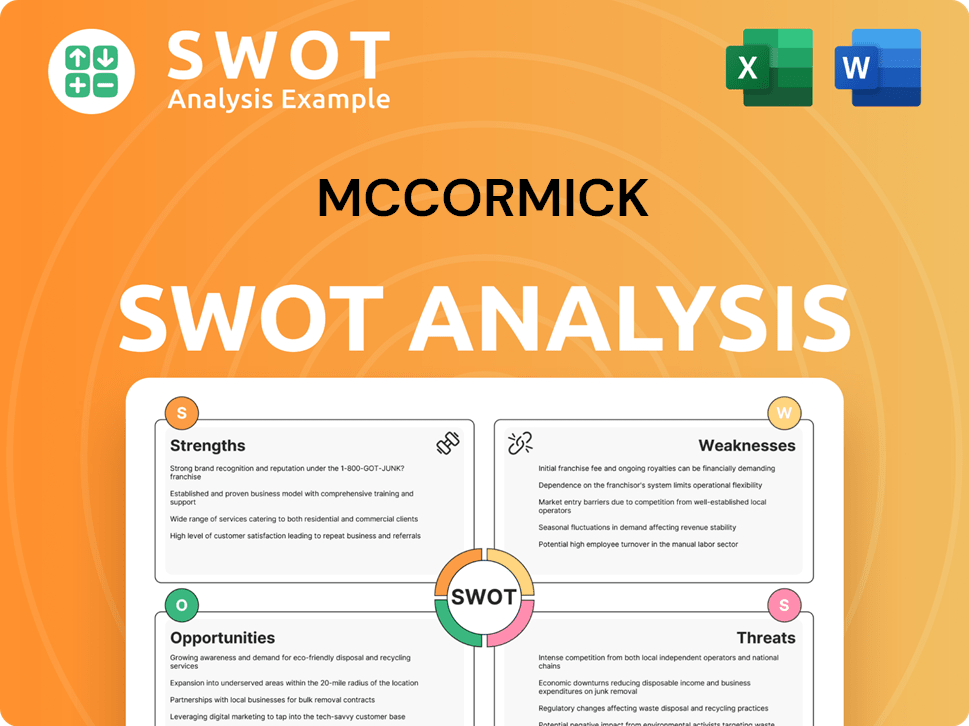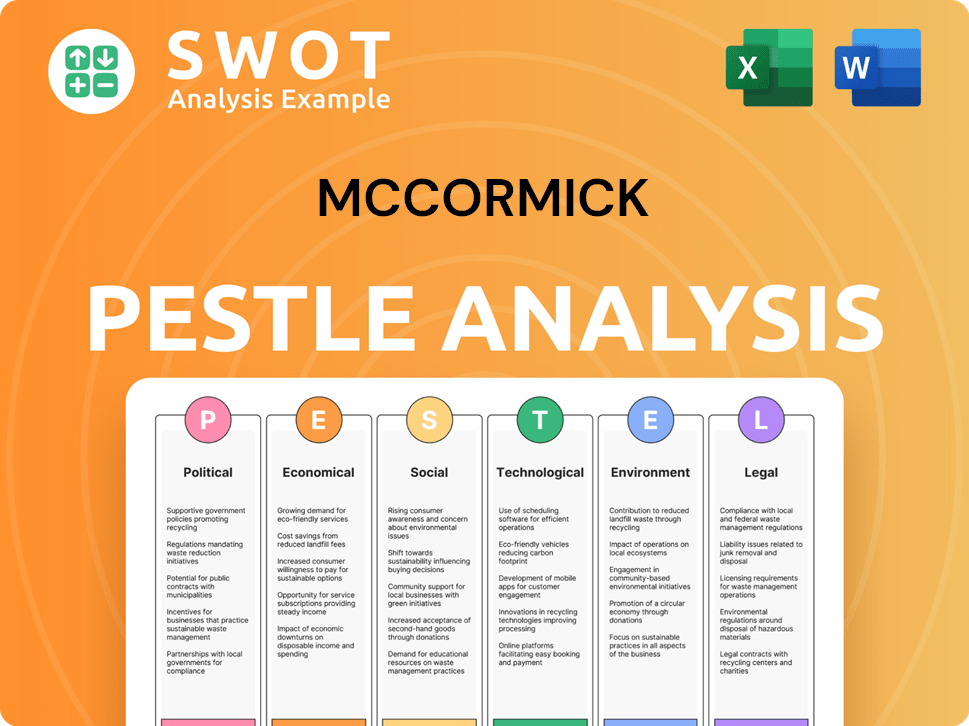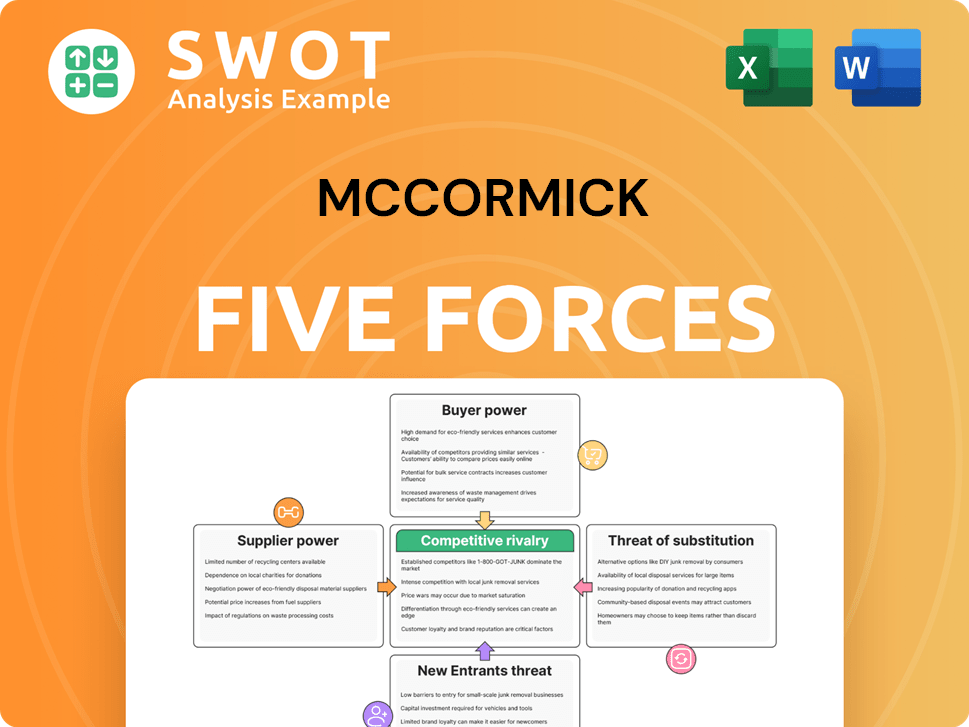McCormick Bundle
How Does McCormick Navigate the Flavor Wars?
The global spice market is a battlefield of flavors, and McCormick & Company has long been a dominant general. From its humble beginnings in 1889, McCormick has grown into a global powerhouse, offering a vast array of spices, seasonings, and flavorings. Understanding the McCormick SWOT Analysis is crucial to understanding its competitive landscape, which is constantly evolving.

This deep dive into the McCormick competitive landscape explores its key rivals and analyzes its market position within the dynamic spice market. We'll examine McCormick's strategies for market dominance, including its competitive advantages and how it navigates the complexities of the food industry competition. Analyzing McCormick's financial performance compared to competitors offers valuable insights into its future outlook.
Where Does McCormick’ Stand in the Current Market?
McCormick & Company holds a significant market position within the global flavor and seasoning industry. The company is a top player, consistently demonstrating a strong presence in the spice market and related segments. In fiscal year 2023, McCormick reported net sales of $6.5 billion, reflecting its substantial scale within the industry.
The company's core operations involve the production and distribution of spices, herbs, extracts, seasoning blends, and condiments. These products cater to a diverse customer base, including retail consumers, food manufacturers, and foodservice operators. McCormick's value proposition centers on providing high-quality, flavorful products that enhance the culinary experience, supported by a global distribution network and a history of innovation.
McCormick's strategic acquisitions, such as Cholula Hot Sauce and Frank's RedHot, have further solidified its position in the condiments category and expanded its appeal to younger demographics. McCormick aims to achieve net sales growth of 2% to 4% in fiscal year 2024. Its financial health remains robust, with a focus on cost savings and supply chain optimization to mitigate inflationary pressures.
McCormick is a leader in the spice market, particularly in North America. While exact figures for 2024-2025 are still emerging, the company has historically maintained a leading share in the retail spice and seasoning segment. This strong market position is a key aspect of the McCormick competitive landscape.
McCormick's product lines include a wide array of spices, herbs, and seasoning blends. The company is strategically shifting its focus towards premiumization and health-conscious offerings. This aligns with evolving consumer preferences and supports its long-term growth strategy in the food industry competition.
McCormick's financial performance is a critical factor in its market position. The company's gross profit margin was 36.9% in the first quarter of 2024. This financial strength enables investment in innovation and expansion. Examining the company's financial performance is crucial for a comprehensive McCormick market analysis.
McCormick boasts a robust global footprint, with significant operations in North America, Europe, Asia, and Latin America. Its extensive distribution network is a key competitive advantage. This wide reach supports its ability to serve diverse markets and maintain its position among global food brands.
McCormick's competitive advantages include its strong brand recognition, extensive product portfolio, and global distribution network. The company's focus on innovation and strategic acquisitions further enhances its market position. For more insights, you can read about Owners & Shareholders of McCormick.
- Strong brand recognition and customer loyalty.
- Diverse product portfolio catering to various consumer needs.
- Global distribution network ensuring product availability.
- Strategic acquisitions to expand market reach.
McCormick SWOT Analysis
- Complete SWOT Breakdown
- Fully Customizable
- Editable in Excel & Word
- Professional Formatting
- Investor-Ready Format

Who Are the Main Competitors Challenging McCormick?
The McCormick competitive landscape is shaped by a diverse array of players in the global food industry. Competition is fierce, spanning both direct and indirect rivals across various segments and geographical locations. Understanding these competitors is crucial for assessing McCormick's market analysis and strategic positioning.
McCormick's competitors range from large multinational corporations to smaller, regional spice companies. These competitors challenge McCormick in different ways, from product offerings to pricing strategies. The company must continuously adapt to maintain its market share and competitive edge.
The spice and seasoning market is highly competitive, with numerous companies vying for consumer attention. The food industry is dynamic, with constant shifts in consumer preferences and market trends. The company must adapt to these changes to remain competitive. For a deeper understanding of how this company approaches its market, you can explore the Marketing Strategy of McCormick.
Direct competitors include global food giants and specialized flavor companies. These companies offer a wide range of products that compete directly with McCormick's core offerings. These companies compete with McCormick through product innovation and marketing strategies.
Kerry Group, based in Ireland, is a significant competitor. They offer a wide range of flavor solutions to the food and beverage industry. Kerry Group's presence in taste and nutrition makes them a formidable competitor.
Givaudan, a Swiss company, is another major player in the flavor and fragrance sector. They provide innovative taste solutions to global food manufacturers. Givaudan's focus on innovation keeps them competitive.
Symrise, a German company, offers a broad portfolio of flavors, fragrances, and nutritional ingredients. They directly compete with McCormick in the industrial and food manufacturing segments. Symrise's diverse portfolio makes them a strong competitor.
These companies often cater to specific ethnic cuisines or niche markets. They challenge McCormick through localized product offerings and competitive pricing. These companies often have a strong understanding of local consumer preferences.
In the condiments space, McCormick's Frank's RedHot and Cholula brands compete with established players. These brands face competition from well-known brands like Heinz and Conagra. These brands compete for shelf space and consumer loyalty.
The competitive landscape is also influenced by private label brands and emerging players. These factors impact McCormick's market share analysis and strategic decisions.
- Private Label Brands: Offered by major retailers, these provide lower-cost alternatives.
- Emerging Players: Focusing on organic, non-GMO, or sustainably sourced products.
- Mergers and Alliances: Acquisitions by larger food conglomerates reshape the market.
- Market Dynamics: Changing consumer preferences and trends in the spice market influence competition.
McCormick PESTLE Analysis
- Covers All 6 PESTLE Categories
- No Research Needed – Save Hours of Work
- Built by Experts, Trusted by Consultants
- Instant Download, Ready to Use
- 100% Editable, Fully Customizable

What Gives McCormick a Competitive Edge Over Its Rivals?
Understanding the McCormick competitive landscape is crucial for investors and analysts. The company, a global leader in the spice and flavor market, faces competition from various players. Analyzing its competitive advantages provides insights into its market position and future prospects. This analysis is essential for anyone looking to understand the dynamics of the food industry competition.
McCormick market analysis reveals a company built on strong foundations. Its success stems from factors like brand recognition, a robust supply chain, and a focus on innovation. Examining these aspects helps to understand how McCormick maintains its competitive edge in a dynamic market, making it a key player among global food brands.
The spice market is highly competitive, and understanding McCormick's competitors is vital. This involves looking at their strategies, market share, and how they stack up against McCormick. Considering the latest trends and financial data provides a comprehensive view of the company's position.
McCormick benefits from strong brand recognition, with brands like McCormick, Lawry's, and Frank's RedHot being household names globally. This trust translates into consistent sales, even amid market fluctuations. The company's long-standing reputation for quality and effective marketing has built significant customer loyalty.
McCormick sources spices and herbs from over 80 countries, providing a diversified supply chain. Its vast distribution channels reach retail, food manufacturing, and foodservice customers worldwide. This extensive network ensures broad product availability and market penetration, a key advantage over competitors.
McCormick achieves cost efficiencies in sourcing, manufacturing, and marketing, which smaller competitors struggle to match. The company invests significantly in research and development, focusing on flavor innovation and health-and-wellness trends. This commitment allows McCormick to introduce new flavor profiles and maintain its leadership.
McCormick's long-standing relationships with growers and its commitment to sustainable sourcing practices enhance its reputation. This secures its access to high-quality raw materials. These practices are increasingly important in the current market, giving McCormick a competitive edge.
McCormick's competitive advantages are multifaceted, including strong brand recognition, a global distribution network, and economies of scale. The company’s focus on innovation and sustainable sourcing further strengthens its market position. These elements collectively contribute to McCormick's ability to outperform its rivals.
- Brand Recognition: Household names like McCormick and Frank's RedHot drive customer loyalty.
- Global Reach: Extensive distribution and supply chain ensure product availability.
- Economies of Scale: Cost efficiencies in sourcing, manufacturing, and marketing.
- Innovation: R&D investments drive new flavor profiles and product development.
For a deeper understanding of McCormick's journey, consider reading Brief History of McCormick. This provides context on the company's evolution and its strategic moves over time. The company's ability to adapt and innovate has been crucial to its sustained success in the spice market. This is a key factor when analyzing McCormick's financial performance compared to competitors. In 2024, McCormick reported net sales of approximately $6.6 billion, demonstrating its strong market presence and resilience. The company's focus on flavor innovation and strategic acquisitions has helped it maintain a competitive edge. The company's global footprint and diverse product portfolio allow it to navigate market challenges effectively, which is important when considering McCormick's market share analysis. The company's ability to manage costs and maintain a strong brand reputation has been critical in the face of impact of inflation on McCormick's competitors. The company's strategies for market dominance include a focus on both organic growth and strategic acquisitions to expand its product offerings and geographic reach. The future outlook for McCormick and its competitors will depend on their ability to adapt to changing consumer preferences and market dynamics.
McCormick Business Model Canvas
- Complete 9-Block Business Model Canvas
- Effortlessly Communicate Your Business Strategy
- Investor-Ready BMC Format
- 100% Editable and Customizable
- Clear and Structured Layout

What Industry Trends Are Reshaping McCormick’s Competitive Landscape?
The flavor and seasoning industry is experiencing significant shifts, influencing the McCormick competitive landscape. Key trends include a rising demand for healthier, sustainably sourced ingredients, and the impact of technological advancements on consumer behavior. These changes present both challenges and opportunities for McCormick, requiring strategic adaptation to maintain its market position.
Understanding the McCormick market analysis is crucial for investors and stakeholders. The company faces risks from supply chain disruptions, inflationary pressures, and intense competition. However, opportunities exist in emerging markets and product innovation. McCormick aims for long-term net sales growth of 4% to 6% and adjusted operating profit growth of 6% to 8%, positioning it for sustained leadership.
Consumers increasingly prefer healthier, natural, and sustainably sourced ingredients. This trend drives demand for organic, non-GMO products and plant-based flavor solutions. McCormick can capitalize on this by expanding its offerings and emphasizing sustainable sourcing initiatives.
Technological advancements in food science and digital engagement impact the McCormick competitive landscape. E-commerce and direct-to-consumer models are growing, necessitating enhancements to digital presence and supply chain agility. Adapting to changing consumer habits is critical.
Ongoing global supply chain disruptions and inflationary pressures pose significant challenges. These factors impact raw material and operational costs. McCormick must navigate these issues while managing intense competition from both established and new players.
Regulatory changes related to food labeling and ingredient transparency could impact product formulations and marketing strategies. Intense competition from established players and agile new entrants also presents a challenge. Strategic adaptation is key for success.
Emerging markets offer significant growth opportunities due to rising disposable incomes and changing dietary habits. Product innovation, including personalized nutrition and authentic global flavors, is a key growth area. Strategic partnerships and acquisitions can also boost market position.
- Expanding Organic Offerings: Capitalizing on consumer demand for natural ingredients.
- Innovating Plant-Based Flavors: Meeting the growing interest in plant-based diets.
- Enhancing Digital Presence: Adapting to the growth of e-commerce and direct-to-consumer models.
- Strategic Partnerships: Strengthening market position through acquisitions and collaborations.
For a deeper dive into McCormick's growth strategies, consider reading about the Growth Strategy of McCormick. The company's ability to leverage its strong brand portfolio, global reach, and commitment to innovation is crucial for navigating the evolving spice market and maintaining its competitive edge within the food industry competition. Key McCormick competitors include major global food brands that are also adapting to changing consumer preferences and market dynamics.
McCormick Porter's Five Forces Analysis
- Covers All 5 Competitive Forces in Detail
- Structured for Consultants, Students, and Founders
- 100% Editable in Microsoft Word & Excel
- Instant Digital Download – Use Immediately
- Compatible with Mac & PC – Fully Unlocked

Related Blogs
- What are Mission Vision & Core Values of McCormick Company?
- What is Growth Strategy and Future Prospects of McCormick Company?
- How Does McCormick Company Work?
- What is Sales and Marketing Strategy of McCormick Company?
- What is Brief History of McCormick Company?
- Who Owns McCormick Company?
- What is Customer Demographics and Target Market of McCormick Company?
Disclaimer
All information, articles, and product details provided on this website are for general informational and educational purposes only. We do not claim any ownership over, nor do we intend to infringe upon, any trademarks, copyrights, logos, brand names, or other intellectual property mentioned or depicted on this site. Such intellectual property remains the property of its respective owners, and any references here are made solely for identification or informational purposes, without implying any affiliation, endorsement, or partnership.
We make no representations or warranties, express or implied, regarding the accuracy, completeness, or suitability of any content or products presented. Nothing on this website should be construed as legal, tax, investment, financial, medical, or other professional advice. In addition, no part of this site—including articles or product references—constitutes a solicitation, recommendation, endorsement, advertisement, or offer to buy or sell any securities, franchises, or other financial instruments, particularly in jurisdictions where such activity would be unlawful.
All content is of a general nature and may not address the specific circumstances of any individual or entity. It is not a substitute for professional advice or services. Any actions you take based on the information provided here are strictly at your own risk. You accept full responsibility for any decisions or outcomes arising from your use of this website and agree to release us from any liability in connection with your use of, or reliance upon, the content or products found herein.